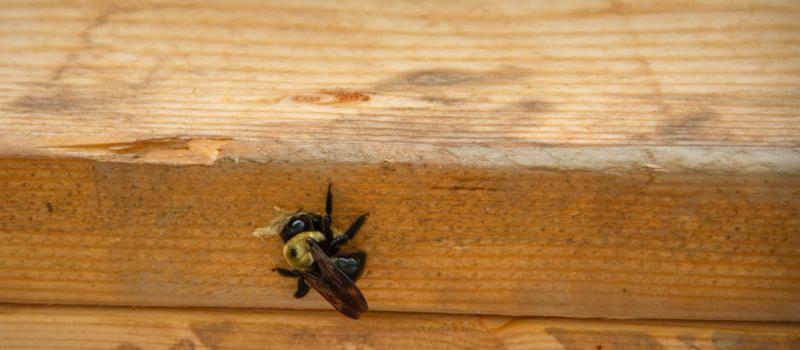How to Keep Carpenter Bees Away from your Deck
Posted by Mosquito Squad
September 27, 2023
Have you ever walked outside and noticed dime-sized holes around the wooden areas of your home's foundation? Or even worse, large streaks of wood are missing with small piles of sawdust strewn about? You may be dealing with carpenter bees, well known nuisances of outdoor decks, sheds, and woodpiles.
Despite the damage they can do to your home, you shouldn't be too quick to evict carpenter bees from your yard! In this blog, I want to focus on how carpenter bees help maintain biodiversity as vital native pollinators and how to effectively and responsibly control carpenter bees.
Bee-lieve it or Not
Though they may be mistaken for bumble bees or honeybees with iconic black and yellow bodies, carpenter bees are different from other bees in many ways.
Carpenter bees (genus Xylocopa) are found throughout the Southern and Eastern US (Arizona to Florida to New York) and are among the more giant bees you may encounter. Their name comes from their ability to drill into dead wood, making holes and burrows for their nesting sites. These nesting sites provide shelter for the bees during unfavorable weather patterns, and female carpenter bees use their burrows to lay eggs. Carpenter bees are solitary, unlike honeybees, and prefer to travel in small numbers of two to six.
While their wood-drilling behaviors may lead you to believe that carpenter bees feed on timber, you might be surprised to learn that woody cellulose is not a part of their diet. Carpenter bees are still bees at the end of the day and require nectar and pollen for their nutrition, though they do not make honey. The carpenter bee diet relies on flowering plants, so carpenter bees are vital in pollinating native wildflower plants.
Carpenter bees are considered the "gentle giants" of the pollinator community. Carpenter bees rarely sting people; male carpenter bees do not have stingers, and female carpenter bees are typically not aggressive and will only sting when provoked.
Prevention
The best way to protect your home from carpenter bee damage is by using preventative measures. When considering adding new additions to your home’s exterior, many state-regulated IPM programs advise installing hardwood (teak, cedar, mahogany) instead of softer woods (balsa, plywood). Carpenter bees have more difficulty drilling through hardwood material and will be more likely to make their nests somewhere other than your porch.
Other prevention methods include inspecting your home's wood foundation for unwanted gaps, cracks, or crevices and removing these potential entry points. Keep in mind that adding a rubbery sealant like caulking may not be an effective long-term solution for carpenter bees. Carpenter bees have strong mandibles that help them chew through wood, and untreated caulk near an entry point is like bubble gum for these insects. When sealing unwanted entry points, consider first adding an insecticide inside the tunnel and leaving the holes open so visiting and returning bees come in contact with the product or detect the repellent. Then, use a small wood dowel to plug the gap.
Carpenter Bee Control
If your carpenter bee problems are beyond preventative measures, there are responsible control methods you can implement to remove carpenter bees from your yard. Like any pest you control, you want to be sure you are not accidentally killing non-target animals and insects. For carpenter bee control, I would not recommend using an aerosol product or bug spray system, as it's easy for the product to drift and accidentally affect other pollinators occupying the same area as the carpenter bees. Instead, I recommend treating the wood directly to discourage carpenter bee activity.
Installing a carpenter bee box trap is a non-toxic and effective control option for minor carpenter bee infestations. You can order or build many different types yourself, but the idea is to create a wood box with a hole in it, mimicking a potential nesting site, and add a funnel inside leading to a collection dish. Carpenter bees will enter looking to nest but won't be able to come out.
Are Pests Still Bugging You?
Call the Pros at Mosquito Squad today to get your insect pest problems under control. To learn more about our control options and additional services, contact us today for a free quote, or call (512) 488-5331.
